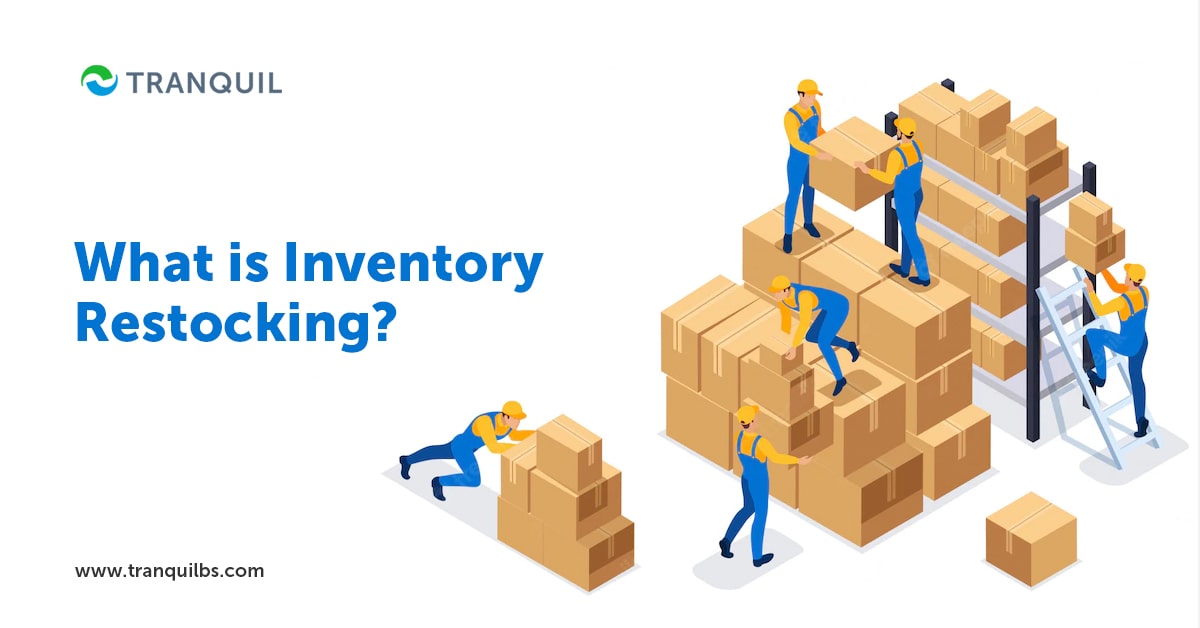
Inventory restocking refers to the way you replenish goods when you need it the most, based on current demand and sales predictions for the near future.
When properly instituted, you can make sure that you stock adequately so that you don’t miss a sales opportunity and don’t overstock and end up with dead stock and high carrying costs.

Restocking is not merely ordering products from a vendor and putting them on your warehouse shelves.
You have to have a very clear picture about various things like current use (sale of production) forecasted demand, the time it will take for the products to be delivered, and so on.
While it is a very important element of inventory optimization, it can become challenging if you can’t predict the future.
Demand shifts can take place because of festivals or seasons, influencers endorsing your product, competitors coming out with similar products, or any other reasons.
This means, anticipating these shifts is not an easy task.
You can still restock inventory strategically depending on your inventory knowledge.
ALSO READ: Top 8 Inventory Reduction Strategies
Optimizing the restocking cycle depends to a great extent on when and how often to restock inventory.
If you implement technology like Tranquil inventory management, you will be able to track inventory in real-time – as your inventory is likely to be continuously moving through your supply chain, and delays are common.
Tranquil will help you calculate optimal reorder levels, and notify you when stocks touch that level.
Reorder levels have to consider the lead time – the time taken for those goods to reach your warehouse from the time you place the order.
ALSO READ: What is Inventory Reorder Point?
As a retailer either online or brick-and-mortar, you have to consider how many variants (SKUs) you sell, and see what items sell quicker or more than the others.
This will help in inventory optimization and restocking depending on the demand for those products.
For example, if blue shirts of the same brand and design sell more than yellow shirts, it doesn’t make sense to stock or order 10 each of both; you may want to order 30 blue shirts and 10 yellow shirts.
If there are any variants that are very slow-moving, you can consider discontinuing them and save on carrying costs.
Tranquil inventory tracking feature gives you comprehensive visibility into inventory levels and shows where the demand is highest.
To know how you can restock inventory quickly and effectively, you need team support and the right technology.
Inventory restocking is not merely reordering materials; you need to think about how much storage you have, the efficiency of your receiving process, how fast you can get the products ready to be sold, and so on.
When your business is scaling up, you may need to increase your order size, but you have to think whether you have the space for the additional stock and if you’ll need major reorganization to be done.
This can take up a lot of time and resources.
ALSO READ: What is Order Up to Level in Inventory Management?
How effectively you manage your returned products also affects your inventory restocking process.
You must process returns quickly so that you understand how many of those items can still be sold, and therefore can go back on your shelves, and how many have to be returned to the vendor or discarded.

Inventory restocking is important but for growing businesses it is critical.
Weak strategies can negatively impact a business at its core.
ALSO READ: Why Use a Barcode For Tracking Inventory And Assets?
When you don’t reorder stock at the right time, you may face stockouts, and this can prove to be very expensive – especially if it happens frequently.
You may have customers cancelling orders, and hence lose sales, and end up losing the customer for good.
They may even leave negative reviews online.
There are several ways you can avoid this, and one way is calculating your safety stock; by maintaining safety stock, you can have a buffer in case of extra demand or delayed deliveries, and fulfil customer demands.
ALSO READ: Inventory Management Trends to Watch Out for
Inventory management methods all have a common goal – optimizing inventory levels.
This is basically a balancing act.
Overstocking is just as problematic as stockouts; while you will be able to fulfil demand, you will have too much left over, eating into your profits, tying up your working capital, hampering your cash flow, and taking a toll on your budget, and resources.
Additionally, you run the risk of ending up with obsolete stock that you can’t sell anymore.
ALSO READ: Advantages of ABC Analysis in Inventory Management
Poor stock management methods can also cause excessive fulfillment costs; after all, the efficiency of inventory restocking affects everything from receiving deliveries to shipping the products.
Supposing, a customer orders a few items from you but a particular item is out of stock.
Now you may have a split shipment situation, where one item may be fulfilled at a later time, or different location.
With two (or more) shipments, you incur higher shipping expenses.
If you have multi-location inventory storage, you must know where to store specific SKUs and in what quantities.
This can help you in having the correct inventory at the correct location to fulfil demand.
Shipping strategy can be optimized by maintaining adequate stock to meet demand in important locations; you can also bring down lead time and shipping expenses.
ALSO READ: What Is Gross Margin Return on Investment (GMROI)?

Now that we know what problems you can face with an ineffective restocking strategy, let us see what methods to follow to prevent them from happening.
First off, it’s important to implement robust inventory management software that will help you streamline inventory, and manage orders and shipments effectively.
Automation can help in efficient inventory tracking and eliminate human errors and save time.
ALSO READ: Detailed Guide on Budget Variance Analysis
This is ideal for small businesses with small order sizes.
Here the cost of goods sold and the inventory are not updated in the company’s books immediately as they happen, and goods are restocked at regular intervals like monthly, quarterly, or annually.
So, even if the inventory suddenly becomes low, restocking will only take place at the predetermined time; conversely, even if a certain item is in stock, it will be ordered again.
This is a simple method that needs little data but you run the risk of stockouts and overstocking.
Without proper data, decision-making becomes tough.
ALSO READ: What is Inventory Aging?
This is used by businesses that stock multiple quick-selling SKUs and is also called lean time replenishment.
It can ensure a high inventory turnover rate and reduce stockout risks while keeping low days sales.
Retailers restock goods to desired levels at all locations whenever there is a spike in demand.
In slow seasons, picking staff have fewer orders to fulfill and can hence be redirected towards restocking.
This method helps boost efficiency during the busy seasons.
By measuring the profitability of an SKU, you can decide whether you want to restock it, and how much to restock.
You can stock higher amounts of more profitable SKUs so that you always have enough to fulfil demand.
When you can track SKU sales and profitability accurately, you can use this method.
ALSO READ: What is a Ledger in Accounting?
As the name suggests, this method means restocking depending on demand forecasts for the future.
Industry experts recommend that to avoid stockout risks during demand surges, it is better to maintain adequate safety stock.

We have established that ill-conceived restocking strategies can negatively impact your business.
You stand to lose sales, incur high carrying costs, lose customers, and experience reduced brand loyalty.
You can follow these tips on inventory restocking optimization so that you mitigate risk while fulfilling demand.
Restocking becomes especially challenging when you expand your business and add more warehouses, sales channels, products, and locations.
The right inventory management software can streamline your business processes from end to end, save time and money, and minimize errors, with automated inventory tracking, providing real-time data, and overall visibility into your inventory at every phase in the supply chain.
This facilitates data-driven decision-making about restocking.
ALSO READ: Complete Guide on Economic Order Quantity (EOQ)
Data is power. And it is critical to have this power at your fingertips.
With inventory data, you can study past trends, predict demand for the future and regulate your inventory levels based on that.
Let us say that you routinely run short of stock around the festive season; you can use data from the last year pertaining to that period, and calculate how much additional inventory you will need to maintain to fulfil the demand for the upcoming festive season.
You will also need to consider your current growth rate to get an accurate figure.
Inventory data can also be used for inventory reporting, or to decide the timing of your next marketing campaign, like a sudden sale to get rid of products nearing expiry.
ALSO READ: Debit notes vs Credit Notes

An inventory audit is a process of verifying the financial and inventory records as in your books of account against the actual (physically counted) inventory levels, which will allow you to have thorough visibility into your inventory.
It will help you in measuring profitability, checking for inventory shrinkage, recognizing inefficiencies, and in reordering stocks accordingly.
All you need to do is just physically count the stock you have on hand, and see if the figures match what you think you have as they are recorded in our books of account.
You can streamline inventory on all levels with regard to the supply chain.
It is especially important to be clear on the kind of inventory to be bought and when it has to be bought.
By carrying out inventory audits, you can see how effective your inventory strategy has been, and you can also get a better idea about the calculation of your profitability.
ALSO READ: What is Job Costing?
Undoubtedly, having a robust inventory restocking strategy is crucial, especially if your business is on a growth trajectory.
How much you want to stock, when you want to replenish, from where, how often, and more, depends on numerous factors, and they differ from industry to industry, and from business to business.
You have to consider the available space, human resources, lead time, current demand, projected demand, and a whole lot of things.
One of the most convenient and quickest ways to achieve optimal inventory restocking is by implementing reliable and efficient inventory management software like Tranquil.
It provides all the data regarding your inventory that you need to make decisions.
After all, the more data-driven your inventory management, the more efficient it is likely to be.
ALSO READ: Why ERP User Interfaces are Important?
Tranquil ERP has feature-rich modules that will help you streamline other business processes too. Do schedule a demo so that we can walk you through the software and help you see how it can benefit your business.